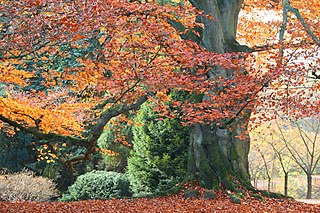
Beech (Fagus) is a genus of deciduous trees in the family Fagaceae, native to temperate Europe, Asia and North America. Recent classifications recognize 10 to 13 species in two distinct subgenera, Engleriana and Fagus. The Engleriana subgenus is found only in East Asia, distinctive for their low branches, often made up of several major trunks with yellowish bark. The better known Fagus subgenus beeches are high-branching with tall, stout trunks and smooth silver-grey bark. The European beech is the most commonly cultivated.
UNESCO Biosphere Reserves are environment-protected scientific-research institutions of international status that are created with the intent for conservation in a natural state the most typical natural complexes of biosphere, conducting background ecological monitoring, studying of the surrounding natural environment, its changes under the activity of anthropogenic factors.

Fagus sylvatica, the European beech or common beech is a deciduous tree belonging to the beech family Fagaceae.

Fagus grandifolia, the American beech or North American beech, is the species of beech tree native to the eastern United States and extreme southeast Canada.

Fagus orientalis, commonly known as the Oriental beech, is a deciduous tree in the beech family Fagaceae. It is native to Eurasia, in Eastern Europe and Western Asia.

The Blithewold Mansion, Gardens and Arboretum is an arboretum of 13 hectares, located at 101 Ferry Road, Bristol, Rhode Island, midway between Newport and Providence, Rhode Island, on Bristol Harbor with views over Narragansett Bay. It includes a mansion, with a 4 hectares lawn and over 300 species of woody plants in its arboretum and gardens, including both native and exotic species.
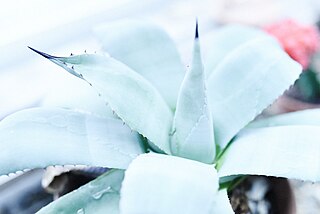
The New Canaan Nature Center is a botanical garden, arboretum and nature preserve located at 144 Oenoke Ridge, Route 124, about .25 miles (0.40 km) north of the center of New Canaan, Connecticut.

The dwarf wych elm cultivar Ulmus glabra 'Nana', a very slow growing shrub that with time forms a small tree, is of unknown origin. It was listed in the Simon-Louis 1869 catalogue as Ulmus montana nana. Henry (1913), referring his readers to an account of the Kew specimen in the journal Woods and Forests, 1884, suggested that it may have originated from a witch's broom. It is usually classified as a form of Ulmus glabra and is known widely as the 'Dwarf Wych Elm'. However, the ancestry of 'Nana' has been disputed in more recent years, Melville considering the specimen once grown at Kew to have been a cultivar of Ulmus × hollandica.

The Siberian Elm cultivar Ulmus pumila 'Pendula' is from northern China, where it is known as Lung chao yü shu. It was classified by Frank Meyer in Fengtai in 1908, and introduced to the United States by him from the Peking Botanical Garden as Weeping Chinese Elm. The USDA plant inventory record (1916) noted that it was a "rare variety even in China". It was confirmed as an U. pumila cultivar by Krüssmann (1962).
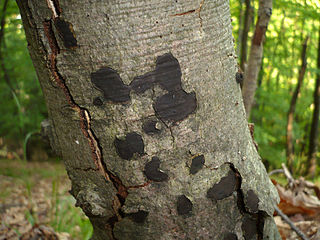
Biscogniauxia nummularia is a plant pathogen in the family Xylariaceae, known as the beech tarcrust. The specific epithet is derived from the Latin "nummus" meaning a coin, referring to the often rounded and coin-like encrustations.

The English Lowlands beech forests are a terrestrial ecoregion in the United Kingdom, as defined by the World Wide Fund for Nature (WWF) and the European Environment Agency (EEA). It covers 45,600 km2 (17,600 sq mi) of Southern England, approximately as far as the border with Devon and South Wales in the west, into the Severn valley in the north-west, into the East Midlands in the north, and up to the border of Norfolk in the north-east of its range. The WWF code for this ecoregion is PA0421.

Calliteara pudibunda, the pale tussock, is a moth of the family Erebidae. The Dutch common name for the moth (Meriansborstel) comes from the butterfly and insect painter Maria Sibylla Merian. The species was first described by Carl Linnaeus in his 1758 10th edition of Systema Naturae. It is found in Asia and Europe.

The Süntel (help·info) is a massif in the German Central Uplands that is up to 437.5 m above sea level (NN). It forms part of the Weser Uplands in Lower Saxony southwest of Hanover and north of Hamelin.

The weeping beech, Fagus sylvatica 'Pendula', is a cultivar of the deciduous European beech. The original tree was found in the grounds of an English park, and it has been propagated by grafting, then many distributed widely.
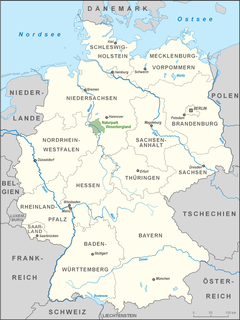
The Weser Uplands-Schaumburg-Hamelin Nature Park lies on the northern edge of the German Central Uplands where it transitions to the North German Plain, about 50 kilometres (31 mi) southwest of Hanover. The sponsor of the nature park, which was founded in 1975, is the state of Lower Saxony. The park extends along the Weser valley between Rinteln and Hamelin and includes parts of the Schaumburg Land, Calenberg, Lippe and Pyrmont Uplands from Bad Nenndorf in the north to Bad Pyrmont in the south, Bückeburg and Bad Eilsen in the west and Bad Münder and Osterwald in the east. Its highest elevation is in the Süntel hills.
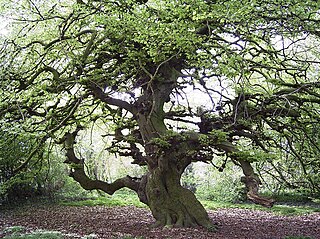
The Deister-Süntel valley lies in the northeast Weser Uplands in the north German state of Lower Saxony between the ridges of the Bückeberg, Süntel and Deister in the districts of Schaumburg and Hameln-Pyrmont.

Central Europe contains several life zones, depending on location and elevation.
A Fau de Verzy is either a Dwarf Beech, a dwarf oak tree, or a dwarf chestnut tree. These grow in the forest of Verzy, 25 km south of Reims in France. In this forest are less than a thousand dwarf beeches, some dozen dwarf oaks and some dwarf chestnuts, but this article speaks in the main about dwarf beeches.

The protected forest area, Uholka-Shyrokyi Luh, is located in the Trancarpathian region of Ukraine and belongs to the Carpathian Biosphere Reserve. It is the largest primeval beech forest worldwide with an area of 8800 ha. Since 1920, some parts of this forest have been protected. In 1992, Uholka-Shyrokyi Luh primeval beech forest was designated as UNESCO World Heritage Site. Later, several other primeval and old-growth beech forests in Europe were included in the UNESCO World Heritage Site Ancient and Primeval Beech Forests of the Carpathians and Other Regions of Europe as well.
As a primeval beech forest, Uholka-Shyrokyi Luh is an important research hotspot. In 2001, a 10 ha research sample plot was installed in Mala Uholka as part of a Swiss-Ukrainian research project, and in 2010 a full statistical inventory of the primeval forest was carried out. The next inventory is planned in 2019 to detect any changes.

The Carpathian montane conifer forests, also known as Carpathian montane forests, is a temperate coniferous forests ecoregion in the Carpathian Mountains of the Czech Republic, Poland, Slovakia, Ukraine, and Romania.




























